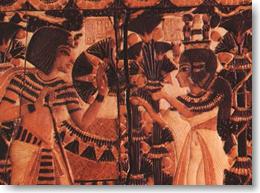|
Digital News Report – King Tutankhamun may have died from complications brought on by malaria, according to research published in the Journal of the American Medical Association. The most famous pharaoh was also the offspring of incest, had a clubbed foot and a cleft pallet (see the list of other pharaohs below).
King Tut ruled ancient Egypt from 1333 to 1323 (or 1324) BC, during the 18th dynasty which lasted from 1550-1295 BC. His brief rein of only 10 years started when he was only 9-years of age. He rejected the radical religious innovations introduced by his father, Akhenaten.
So what is so special about Tut? His tomb and remains were discovered intact by Howard Carter in 1922. The burial was not looted like so many other sites. There was gold and other riches discovered.
Previously scientists speculated that he may have died from foul-play. However new evidence suggests he died of natural causes. He was worshiped as a god and honored with a cult-like following in his own lifetime,.
A hole in his skull, once thought to be the result of an assassin, was found to be part of the mummification process. After two years of DNA testing and CT scans it appears the king died of complications from a broken leg exacerbated by malaria.
His mother may have been a sister of his father. All of the members of the later kingdoms were probably inbred. He may have suffered from several genetic disorders and may have needed a cane to walk. His father had a cleft pallet and his grandfather had a clubbed foot.
DNA tests are being run on others mummies to determine lineage. Here is a list of the rulers during the 18th dynasty:
|
By: Sam Lee
Science Writer

